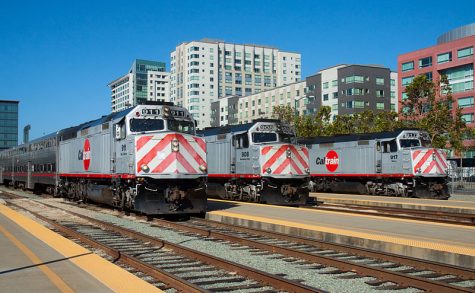Caltrain on Track for New Improvements
The Caltrain is a state-specific mode of transportation that accommodates many passengers for a variety of purposes. It should be known that some important changes will be made to local stations within the next few months. The Caltrain station in Sunnyvale is currently undergoing a $753,000 “Station Rehabilitation Project” to make the station safer to access, reports Caltrain. This rehabilitation will include relocating existing pedestrian paths eighty feet northwest and extending the platform length so that six car transits can operate safely. According to Caltrain officials, surrounding concrete will be freshly resurfaced with pavers to ensure even and smooth loading areas. While the project was approved in September of last year, construction officially began in mid-March and may continue up until August of this year.
Construction for this project is due to take place on weekdays, where local neighbors may hear the active improvements and machinery. The local community may see a complete demolition of station platforms, as the rehabilitation entails, as well relocation of passenger shelters and mini-high platforms. Parking spaces will also be limited to facilitate construction. Frequent riders of the system may see single tracking, where only one track will be used for train travel in both directions. In addition to this, bike users may have to board using the north outlet to carry their bikes onboard, as southern bike cars will be off-duty well into May.
Earlier in the year, the “Senate Bill 1,” meant to improve statewide transportation, helped prompt the $2.5 million grant Caltrain received from the California Department of Transportation. The budget for the grant includes using one million dollars in rehabilitation projects and another million dollars for crossover tracks to detour trains for efficient traveling and use of tracks. The remaining $500,000 will be used for the Caltrain Bike Parking Management Program to improve bike parking and the different options that may be available.
Other improvements that are set to take place in the future include the introduction of Wi-Fi to Caltrains. In regards to previous requests for Wi-Fi, Caltrain officials have claimed that needs would be delayed as, “a system that is reliable and robust enough to meet the needs of our riders,” had not yet been found. However, according to The Daily Californian, Caltrain is expecting to see Wi-Fi on its trains by 2021. As Caltrain Communications Officer Tasha Bartholomew claims, “Wi-Fi is a possible feature for better customer experience. We carry close to 65,000 riders a day. … Almost everyone has a smartphone.” However, this feature seems to be paired with a new fleet of electric trains that the commuter rail line is hoping to unveil within the next few years. This project, named the Peninsula Corridor Electrification Project, is expected to retain twenty-five percent of its remaining diesel trains, while revamping the remaining seventy-five percent of cars to run with electric power. Caltrain also received funding from the California High Speed Authority to go forward with their Draft 2018 Business Plan as it, “proposes new strategies that would expand electrification of the Caltrain corridor ensuring that communities…will benefit from the advantages offered by electric train.” Such benefits are expected to be improved air quality, shorter travel times, and greater service frequency. Looking forward, it seems that high speed rail services are planned for the future, possibly making its appearance in 2027 to “address growing traffic congestion and maintain our economic competitiveness.” Jeanne Bruins, chair member of the Caltrain Board of Directors expressed her enthusiasm for the growing number of electric cars in the system, stating that growing cities will have, “a tremendous step toward providing them with the transportation infrastructure they need to accommodate that growth.”
Caltrain has come far in its recent technological developments, as the first commuter railroad in California was only created in 1963 by Southern Pacific. In 1980, then “Caltrans” had its more local operations funded by SP to have shuttle buses and stations fully functional in 1985. It was officially dubbed Caltrain in 1992 when The Peninsula Corridor Joint Powers Board took over operations. The official vision of the Caltrain is to, “provide a safe, reliable, sustainable modern rail system that meets the growing mobility needs of the San Francisco Bay Area region,” which has been met with ongoing developments to the locomotive system.






